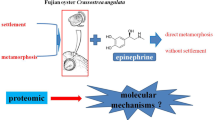Abstract
Larvae of the marine cheilostomatid bryozoan Bugula neritina (L.) were prevented from settling for 1, 4 and 8 h by mechanical agitation, following which settlement and metamorphosis success were examined. Settlement rates were significantly affected by swimming time, which decreased from 100% after 2 h to 93.7 ± 4.3% after 8 h. Similarly, metamorphosis to the feeding ancestrula was significantly impaired following a swimming time of 8 h, declining from 93.7 ± 4.3% after 1 h to 65.9 ± 7.0% after 8 h. The resultant colonies grew well for the first 3 wk, following which time, growth patterns became erratic. Growth rate was in all cases highly variable, and did not correlate with enforced swimming times. Larval protein composition was examined after 1, 4 and 8 h swimming time, and post-larval composition 1, 2, 5, 24 and 48 h after settlement using sodium-dodecyl-sulphate polyacrylamide-gel electrophoresis (SDS-PAGE). Individual protein content was measured using a densitometer. Larvae did not consume protein during swimming, however a protein measuring 170 kdaltons was consumed during metamorphosis. These results are discussed in the context of larval settlement and energetics.
Similar content being viewed by others
Author information
Authors and Affiliations
Additional information
Received: 19 July 1998 / Accepted: 3 December 1998
Rights and permissions
About this article
Cite this article
Hunter, E., Shimizu, K. & Fusetani, N. Role of protein in larval swimming and metamorphosis of Bugula neritina (Bryozoa: Cheilostomatida). Marine Biology 133, 701–707 (1999). https://doi.org/10.1007/s002270050511
Issue Date:
DOI: https://doi.org/10.1007/s002270050511




